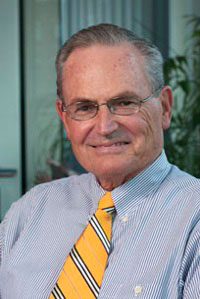Lobster Marketing Collaborative
Moves Forward
by Laurie Schreiber

John Sauve, managing partner of the Portland-based Food and Wellness Group, and a veteran of over 40-years in the corporate and commodity sectors of the food industry.
PORTLAND – Aggressive brand-name marketing for Maine lobster is the goal of the new Maine Lobster Marketing Collaborative (MLMC), a marketing entity recently established by the legislature to replace the Maine Lobster Promotion Council.
John Sauve, managing partner of the Portland-based Food and Wellness Group, and a veteran of over 40-years in the corporate and commodity sectors of the food industry, is guiding a transition that involves compiling and analyzing lobster marketing and branding research and assisting the MLMC in the creation of a three-year strategic and operating marketing plan, which will be presented to the legislature in January 2014.
Sauve’s involvement was initiated by Department of Marine Resources (DMR) Patrick Keliher, with the goal of ensuring that MLMC members have the information they require to implement new marketing programs as quickly as possible, according to the DMR.
Sauve said that, as the consultant on the project, he preferred not to act as media contact on the initiative. He referred Fishermen’s Voice questions to DMR communications chief Jeff Nichols, who said the collaborative has not been convened yet.
“The nominees for the collaborative are coming in” for consideration and appointment by Keliher, Nichols said. The goal is to appoint members in time for an initial meeting in early November. Nominations are coming in from the zone councils and the DMR’s lobster advisory council.
The idea behind the new entity represents a commitment to the collaborative process, not only with industry members but with members whose area of expertise is in marketing and food sales, Nichols said.
“The desire is to focus this investment from industry on a really aggressive domestic and international marketing effort, he said.
Keliher decided to engage Sauve to assist with the transition because of the tight timeframe, he said.
“He’s aware of the tight timeframe and the need to have someone with John’s unique experience facilitate this process,” Nichols said.
The marketing initiative will be funded by surcharges on lobster and dealer/processor licenses. For the first year, that’s expected to amount to $750,000. That figure will ramp up to $1.5 million in the second year, then $2.2 million the third year. The first surcharges that will result in the start of the initiative will be those collected in this upcoming license year, 2014.
At the same time, he said, the MLMC has its work cut out to develop a strategic marketing plan. Although it’s unclear when the industry might see improved returns from any plan that’s put in place, “There’s a commitment to start seeing the value of this investment quickly,” said Nichols. “I think there will be a strong push to have a return on this investment the first year.”
Sauve will assist the MLMC in its search and selection of a new advertising and promotion agency, and help create a new management and operating structure for the MLMC.
Sauve’s work began in August and runs through January 2014. The decision regarding long-term staffing for the MLMC, including the executive director, will be made by the MLMC when they begin their work.
Sauve is president of the Portland-based Food and Wellness Group. He guided strategic marketing for the cross-border Wild Blueberry Association of North America, as well as a variety of other products, from French cheese and potatoes, to milk and probiotics. Previous positions include leadership of the Food and Nutrition practice at Swardlick Marketing Group; executive director of the Wild Blueberry Association of North America; a principal with the Hale Group, a Boston-based management consulting firm, where he provided strategic counsel to the foodservice and restaurant industries; and vice president of marketing for Friendly Ice Cream Corporation.
“This transition to a new marketing era is a major milestone in the long and storied history of Maine lobster,” said Keliher said in a press release.
In the most recent issue of the Maine Lobstermen’s Community Alliance’s monthly newsletter, Sauve said he would draw on his work with the blueberry industry to inform the transition to the new lobster marketing entity.
His consulting assignment for the blueberry group was to help an industry management team analyze the state of the industry and identify marketing approaches for increasing demand. By 1992, he said, it was clear that the supply of wild blueberries was on the increase and that demand “needed to outpace supply for the industry to remain profitable at all levels.”
In the decade from 1991 to 2001, Maine’s blueberry harvest nearly doubled, from 39.5 million pounds to 75.2 million pounds. By 2012, the harvest increased to 91.1. million pounds. Canada saw an even stronger uptick.
“My job was to help the industry think through the marketing elements that could drive profitable market growth,” Sauve said in the Landings article. “My message to the board was, ‘Think like a brand’ and not just as a commodity.”
In 2011, Sauve worked with the Lobster Advisory Council to develop a strategic structure aimed at enhancing the brand identity of, and increasing demand for, Maine lobster.
